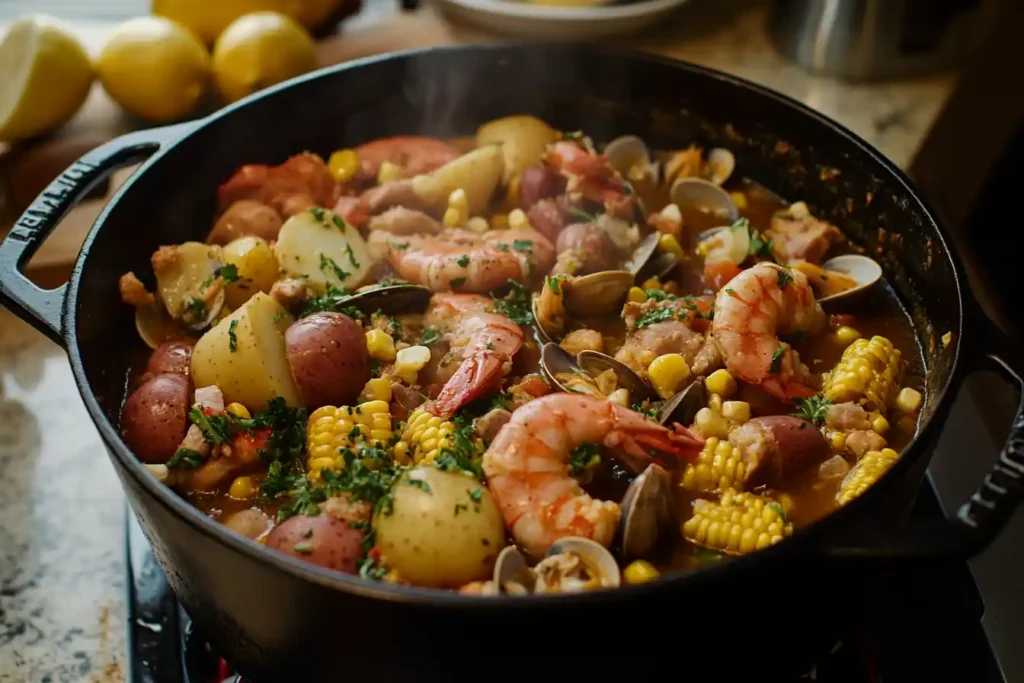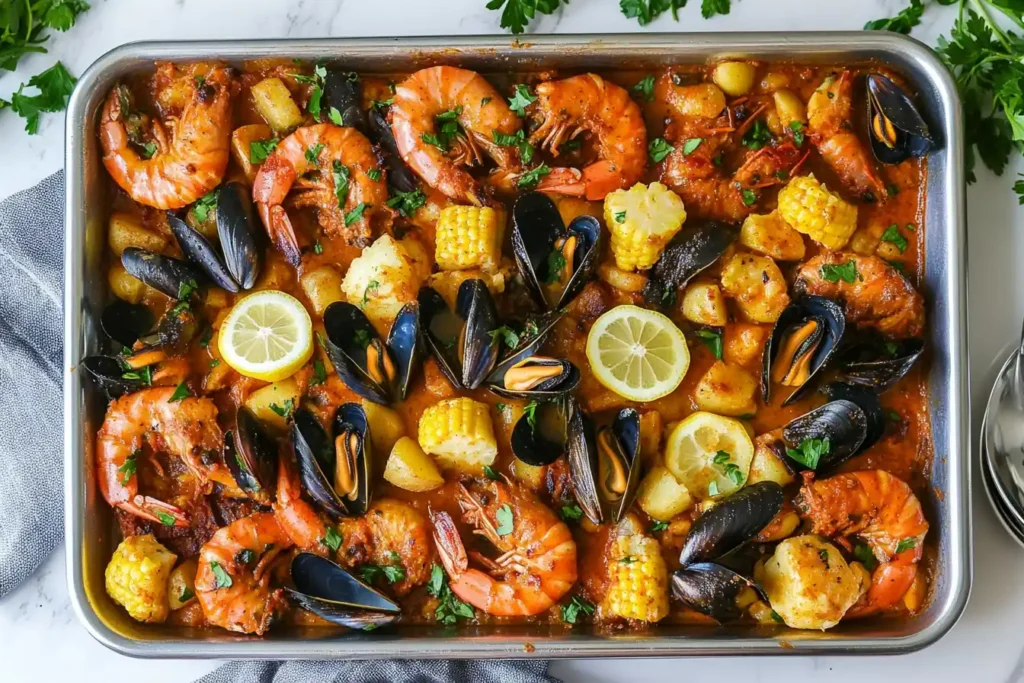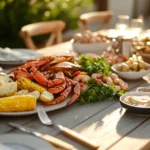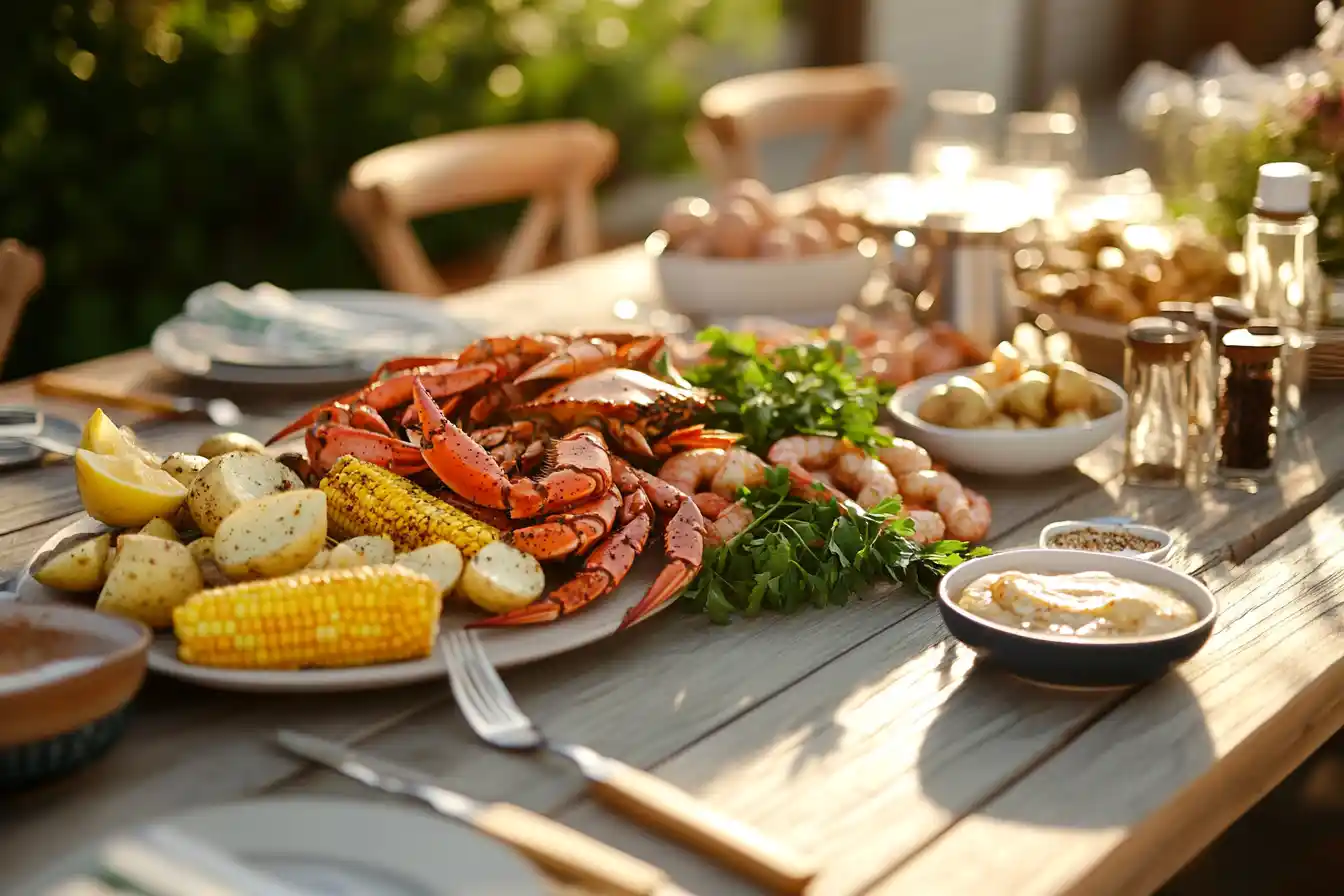Discover how to create a delicious sea food boil recipe, including tips, techniques, and serving suggestions.
How a Backyard Seafood Boil Became My Favorite Way to Feed a Crowd
It started with a craving—something warm, messy, flavorful, and fun. I had some shrimp in the freezer, a few ears of corn from the market, and an afternoon free. I wasn’t planning a dinner party, but before I knew it, I had texted a few neighbors, pulled out the big stockpot, and started putting together what would become one of the most unexpectedly joyful meals I’ve ever made.
I didn’t grow up with seafood boils, but the first time I made one, it felt like I had uncovered some sort of magic. There was something about tossing simple ingredients into one pot—potatoes, sausage, garlic, and fresh seafood—and letting the flavors mingle and build into something bigger than the sum of its parts.
That first boil wasn’t fancy, but it was everything I love about cooking: unfussy, full of flavor, and made to share. We laid everything out on paper in the middle of the table, no plates, no formality—just hands reaching, butter dripping, and lots of laughter. It wasn’t about presentation; it was about connection.
What I love most is how adaptable it is. You can use what you have, switch up the seasonings, stretch it to feed a crowd, or scale it down for a smaller crew. It’s comfort food with a coastal twist—and it doesn’t have to break your budget.
Now, whenever the weather warms up or I need a meal that brings people together, this is what I turn to. A seafood boil isn’t just a recipe—it’s an experience. And once you make it once, you’ll find yourself looking for excuses to make it again.
Essential Ingredients for the Best Sea Food Boil Recipe
Initially, assembling top-quality ingredients is crucial. Essentially, a proper sea food boil recipe begins with fresh seafood. Chiefly, shrimp, crab legs, clams, and mussels form the foundation. Meanwhile, hearty vegetables add depth and color. Explicitly, consider ears of corn, new potatoes, and slices of smoked sausage. Altogether, these items form a hearty meal that needs no side dish to shine.
However, seasonings matter just as much. Typically, Cajun blends, smoked paprika, bay leaves, and aromatic herbs define the flavor profile. Particularly, Old Bay Seasoning or a similar spice mix enhances that signature taste. Comparatively, fresh garlic, onion, and celery impart savory undertones. Undoubtedly, these elements converge into a layered, comforting broth.
Moreover, consider adding citrus elements. A few lemon wedges or fresh orange slices brighten the broth. Thus, the final dish brims with balanced flavors. Basically, the right ingredients create a feast that merges sweetness, spice, and savory goodness. Likewise, using quality seafood ensures tenderness and juiciness. Therefore, invest time in seeking out the freshest catch available.
Selecting and Storing Fresh Seafood
Especially when dealing with seafood, freshness is paramount. Initially, visit reputable fishmongers or trusted supermarket counters. Comparatively, check for bright eyes, firm flesh, and a clean scent. Generally, shellfish should appear tightly closed. If any shells remain open, tap them lightly. If they fail to close, discard them.
Subsequently, store your seafood properly. Another important step is placing shrimp, crab, and shellfish over ice. Furthermore, keep them chilled until you start cooking. Conversely, never let raw seafood linger at room temperature. Particularly, maintain proper handling to ensure safety and flavor. Consequently, careful storage preserves texture, taste, and quality.
Additional Flavor Enhancements
Undoubtedly, a sea food boil recipe benefits from creative additions. Initially, consider complementing the flavors with smoked sausage, chorizo, or andouille. Moreover, add depth by incorporating fresh herbs like thyme or parsley. Equally, consider tossing in whole garlic cloves to infuse the broth with a mellow, roasted flavor.
Subsequently, enhance richness with butter. Melted butter drizzled over the final platter offers indulgent creaminess. Another helpful tip involves stirring in a splash of white wine or beer for complexity. Consequently, these additions bring subtle layers, making every bite enjoyable. In particular, dipping sauces, like melted garlic butter or a tangy cocktail sauce, further elevate the dish.
Common Mistakes to Avoid
However delicious, some errors can undermine the final outcome. Initially, avoid overcooking the seafood. Comparatively, shrimp turn rubbery if boiled too long, and crab legs become dry. Therefore, monitor cooking times closely. Another common mistake is under-seasoning. Consequently, the flavors will lack depth and intensity. Thus, taste frequently and adjust seasonings as you go.
Equally important, do not crowd the pot. Large batches can reduce boiling temperature and result in uneven cooking. Meanwhile, failing to layer ingredients properly can yield inconsistent textures. Initially, add items with longer cooking times first. Subsequently, introduce delicate seafood toward the end. Finally, remember to let your boil rest briefly before serving. This pause allows flavors to meld harmoniously.
Serving Suggestions and Perfect Sides
Eventually, how you serve your sea food boil recipe can enhance the entire experience. Moreover, consider pouring the entire contents onto a covered table. In many traditions, the boil is served family-style. Consequently, guests gather around and dig in together. Comparatively, using newspaper or butcher paper adds a rustic feel. Furthermore, it simplifies cleanup.
Additionally, think about side dishes. A crisp green salad, a loaf of crusty bread, or a bowl of coleslaw complements the boil. Another option involves adding spiced rice or a side of roasted vegetables. Ultimately, the goal is to provide variety and texture. Indeed, serving your sea food boil recipe with fresh lemonade or a chilled beer further completes the meal.
Step-by-Step Cooking Guide: Creating Your Sea Food Boil Recipe

Finally, let’s walk through the complete process. Basically, these steps outline everything from prep to presentation. Initially, prepare your ingredients and set a large pot over a heat source. Eventually, follow these steps to achieve a perfect boil every time.
Prepping the Seafood for the Sea Food Boil Recipe
Initially, rinse your chosen seafood under cold running water. Consequently, remove any debris or loose shells. Particularly, devein shrimp if needed, and discard unwanted parts. Meanwhile, sort through clams and mussels, discarding any that remain open after tapping. Equally, ensure crab legs are free of grit. Additionally, pat everything dry before proceeding.
Eventually, place all seafood in a bowl and keep it chilled. Another critical step involves prepping your vegetables. Cut corn into manageable segments, wash potatoes, and slice sausage. Basically, organize all components, so they’re ready for layering.
Seasoning the Pot: Spices and Herbs for the Sea Food Boil Recipe
Initially, fill a large pot with enough water to cover your ingredients. Indeed, consider adding a bottle of beer or a cup of white wine for extra flavor. Meanwhile, bring the liquid to a rolling boil. Consequently, toss in aromatics like onion, celery, and bell pepper. These three ingredients form the “Holy Trinity” in many seafood boils, providing a crucial flavor base.
Subsequently, add bay leaves, garlic, and a generous scoop of spice blend. Particularly, Old Bay Seasoning or a Cajun mix works well. Furthermore, squeeze in fresh lemon juice. Thus, the broth should smell fragrant and inviting.
Afterward, add potatoes first. They take longer to cook, so they need a head start. Eventually, include your sausage, letting its smoky flavor infuse the pot. Equally, if you’re using crawfish or crab, add them next. Meanwhile, ensure each addition brings the broth back to a boil before proceeding.
Finishing Touches: Serving Your Sea Food Boil Recipe in Style

Eventually, add your shrimp last, as they cook rapidly. Consequently, watch closely and remove the pot from heat as soon as shrimp turn pink. Conversely, overcooking shrimp leads to a chewy texture. Another vital step involves letting the pot rest off the heat for a few minutes. Thus, the flavors meld together perfectly.
In addition, taste the broth and adjust seasonings. Sprinkle in additional spices if needed, or add a pinch of salt. Meanwhile, consider garnishing with fresh parsley or extra lemon slices. Initially, drain the broth or serve the dish with some cooking liquid for dipping. Undoubtedly, this final stage ensures every element is at peak flavor.
Finally, pour the entire contents onto your serving surface. Add melted butter on the side for dipping. Consequently, everyone can savor the feast. Another great tip is to provide plenty of napkins, as this dish often involves eating with your hands. Ultimately, enjoy the relaxed and interactive dining experience.
Variations on the Classic Boil
Likewise, experimenting with variations keeps things exciting. While shrimp, crab, and crawfish remain popular, consider adding lobster tails or scallops. Furthermore, swap out potatoes for sweet potatoes, or add baby artichokes for complexity. Specifically, try experimenting with different spice blends. For example, a jerk seasoning or a garlicky herb blend can refresh the classic taste.
Moreover, consider incorporating seasonal produce. In summer, use fresh corn, while in cooler months, add hearty root vegetables. Another variation involves using smoked seafood or grilled sausage for depth. Consequently, your sea food boil recipe becomes a versatile template that adapts to personal preference.
Nutritional Insights and Health Considerations
Comparatively, a sea food boil recipe can be relatively healthy. Generally, shellfish provides lean protein and essential nutrients. Meanwhile, vegetables contribute vitamins and fiber. Another beneficial aspect is the minimal use of added fats. Instead, flavor comes from herbs, spices, and aromatics.
Nevertheless, pay attention to sodium levels. Because many spice blends contain salt, taste as you go. Therefore, adjust seasonings to ensure a balanced profile. Additionally, if you want to reduce calories, use less butter or skip high-fat sausages. Conversely, adding more vegetables increases nutrient density. Altogether, mindful choices help you enjoy this feast without guilt.
The Importance of Presentation
Undoubtedly, presentation matters. Indeed, a visually appealing spread adds excitement and anticipation. Meanwhile, bright colors, contrasting textures, and a neat arrangement make a difference. Comparatively, garnish with fresh herbs and citrus wedges. Consequently, guests will admire your culinary creativity.
Furthermore, serve on large platters or spread out over a covered table. Another trick is to provide small bowls of dipping sauces. Eventually, everyone can customize their own bites. Equally, well-chosen serving tools, like small forks and shell crackers, enhance the experience. Ultimately, your sea food boil recipe becomes a feast for all senses.
Seasonal and Regional Influences
Particularly, sea food boil recipe traditions vary by region. In coastal Louisiana, crawfish boils feature intense Cajun spices. Meanwhile, in the Carolinas, low-country boils highlight shrimp and crab. Conversely, Northeastern clambakes rely heavily on clams and lobsters. Indeed, these regional touches add unique character.
Similarly, consider seasonal influences. In summer, fresh corn and tomatoes shine. Eventually, in colder months, heartier vegetables and crab legs might dominate. Comparatively, different spice blends adapt to changing tastes. Therefore, your boil remains a dynamic dish that evolves over time. Altogether, these variations keep the concept fresh and exciting.
Boosting Flavor with Dipping Sauces
Another method to enhance flavor involves dipping sauces. For example, a simple garlic butter sauce pairs well with crab and shrimp. Furthermore, a zesty cocktail sauce or a tangy remoulade adds a punch of heat. Equally, consider a citrusy aioli or a creamy herb dressing for contrast.
Subsequently, present sauces in small bowls around the table. Consequently, guests experiment with different combinations. This approach fosters creativity and personal preference. Ultimately, sauces provide an opportunity to personalize the meal. Indeed, a sea food boil recipe becomes even more unforgettable with the right condiments.
Pairing Beverages with Your Boil
Similarly, beverages play a crucial role. For instance, a crisp white wine, such as Sauvignon Blanc, complements delicate seafood flavors. Meanwhile, light beers, wheat ales, or lagers refresh the palate. Conversely, sweet iced tea or lemonade offers a non-alcoholic option. Particularly, these drinks counter spicy seasonings and cleanse the taste buds.
Furthermore, consider serving flavored sparkling water or a citrus punch. Eventually, the right beverage pairing heightens the dining experience. Comparatively, richer beers or stouts might overwhelm delicate seafood. Therefore, stick to lighter, more refreshing options. Altogether, balancing flavors and textures ensures a harmonious meal.
Hosting a Memorable Seafood Boil Party
If hosting a gathering, consider a themed event. Basically, decorate with nautical elements: rope centerpieces, seashell accents, and striped linens. Another idea involves providing bibs or personalized napkins for guests. Consequently, these little touches create a festive mood.
Additionally, prepare extra sides and sauces in advance. Thus, you can focus on cooking and entertaining when guests arrive. Eventually, invite friends to assist in peeling shrimp or setting the table. Doing so makes the meal feel interactive and fun. Undoubtedly, a sea food boil recipe party becomes a cherished memory.
Embracing Tradition and Innovation
Balancing tradition and innovation keeps things interesting. On one hand, respect the classic approach of simple seasoning and fresh ingredients. Conversely, add your own twist by introducing unique flavors or textures. Thus, you honor the heritage of the dish while ensuring it evolves.
Furthermore, pass down your favorite variation to friends and family. Consequently, these gatherings become rituals, strengthening bonds. Equally, as you perfect your sea food boil recipe, you inspire others to try it. Eventually, this tradition thrives, ensuring future generations appreciate its charm.
Sustainability Considerations
Another factor involves sustainability. Equally, choose responsibly sourced seafood. Check fishing methods and consider environmental impact. Thus, your meal respects the ocean’s resources.
Similarly, minimize waste. For example, use vegetable scraps in stock or compost shells and corn cobs. Consequently, you create a meal that honors the environment. Undoubtedly, a conscientious approach ensures you savor your feast with a clear conscience.
Perfecting the Timing and Temperature
Precisely controlling cooking times is crucial. Generally, start with the longest-cooking ingredients like potatoes and sausage. Subsequently, add crab legs and clams, followed by shrimp. Eventually, remove the pot from heat when seafood just turns opaque. Thus, you achieve tender, succulent textures every time.
Furthermore, monitor the pot’s heat carefully. Indeed, a rolling boil is essential, but adjust temperature to maintain it consistently. Another tip is to use a large enough pot, providing space for all ingredients. Ultimately, these careful steps ensure a flawless sea food boil recipe outcome.
Keeping Things Fun and Relaxed
A sea food boil recipe should feel relaxed. Undoubtedly, the informal nature encourages finger-licking enjoyment. Meanwhile, you need not worry about formal plating. Comparatively, simply enjoy the feast with friends and family.
Basically, the less complicated the setup, the better. Another reason this dish is popular lies in its simplicity. Therefore, focus on fresh ingredients, correct timing, and good company. Eventually, the result is a meal that lingers in everyone’s memory.
Frequently Asked Questions (FAQs)
What is seafood boil sauce made of?
A seafood boil sauce often contains butter, garlic, spices, herbs, and citrus juice. Particularly, Old Bay seasoning or Cajun blends add depth. Conversely, some recipes include Worcestershire sauce or hot sauce for extra heat.
What does a seafood boil contain?
A typical seafood boil contains shrimp, crab legs, clams, and mussels. Additionally, corn, potatoes, sausage, and aromatic vegetables are common. Eventually, spices, herbs, and lemon wedges round out the flavors.
What is the Holy Trinity in seafood boil?
The Holy Trinity refers to onions, celery, and bell peppers. Chiefly, these three vegetables form the flavor base of many Southern dishes. Consequently, they provide a savory, aromatic foundation for your sea food boil recipe.
What goes best with a seafood boil?
Many sides pair well with a seafood boil. For example, coleslaw, cornbread, or a crisp green salad complement flavors. Furthermore, crusty bread, melted butter, and various dipping sauces enhance the dining experience. Finally, serve refreshing beverages like white wine, beer, or iced tea.

Sea Food Boil Recipe
- Total Time: 50 minutes
- Yield: 6 servings 1x
Description
This Sea Food Boil Recipe is a flavorful feast perfect for gatherings, backyard parties, or weekend indulgence. Packed with tender shrimp, juicy crab legs, hearty potatoes, sweet corn, and smoky sausage, all simmered in a boldly seasoned broth—it’s a hands-on, family-style meal that celebrates coastal traditions and unforgettable flavors.
Ingredients
1 lb large shrimp, shell-on
1 lb crab legs
1 lb clams or mussels (cleaned and debearded)
12 oz andouille or smoked sausage, sliced
4 ears of corn, halved
1 lb baby potatoes
1 onion, quartered
3 cloves garlic, smashed
2 celery stalks, chopped
2 bay leaves
1 lemon, halved
1/4 cup Old Bay Seasoning (or Cajun seasoning)
1 tablespoon smoked paprika
1 tablespoon salt
1 teaspoon black pepper
6 cups water (or 5 cups water + 1 cup beer or white wine)
1/2 cup unsalted butter, melted (for serving)
Fresh parsley and lemon wedges (for garnish)
Instructions
-
In a large stockpot, add water (and beer or wine if using), onion, celery, garlic, lemon halves, bay leaves, Old Bay, smoked paprika, salt, and pepper. Bring to a boil.
-
Add baby potatoes and boil for 10–12 minutes, until nearly tender.
-
Add sausage and corn; cook for another 5 minutes.
-
Add crab legs and clams/mussels; cook for 5–7 minutes until shellfish begins to open.
-
Finally, add shrimp and cook for 2–3 minutes, until shrimp turn pink and opaque.
-
Remove pot from heat and let rest for 5 minutes to let flavors meld.
-
Drain and transfer all contents to a large platter or parchment-lined table.
-
Drizzle with melted butter, sprinkle with fresh parsley, and garnish with lemon wedges.
-
Serve immediately with dipping sauces and plenty of napkins!
Notes
To keep things fun and interactive, serve on newspaper or butcher paper.
Swap crab legs with lobster tails or add scallops for a luxe variation.
For extra kick, stir a pinch of cayenne or red pepper flakes into the broth.
Don’t skip the rest time—it allows flavors to fully soak into the ingredients.
- Prep Time: 20 minutes
- Cook Time: 30 minutes
- Category: Dinner
- Method: Boiling
- Cuisine: Southern/Coastal American
Nutrition
- Serving Size: Approx. 1.5–2 cups per person
- Calories: 420 kcal
- Sugar: 4g
- Sodium: 1100mg
- Fat: 22g
- Saturated Fat: 8g
- Unsaturated Fat: 10g
- Trans Fat: 0g
- Carbohydrates: 26g
- Fiber: 3g
- Protein: 32g
- Cholesterol: 190mg
Keywords: sea food boil recipe, shrimp and crab boil, Cajun seafood boil, easy seafood dinner, summer seafood feast, one-pot seafood boil

